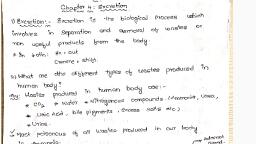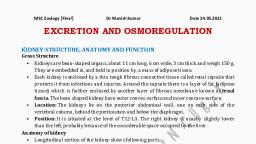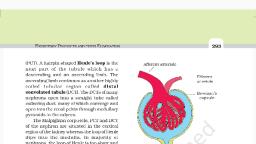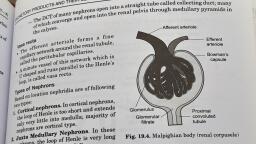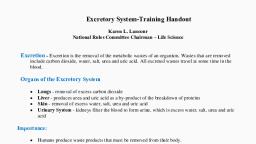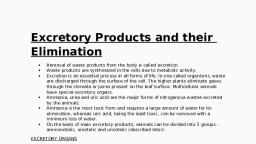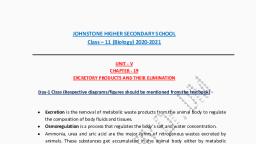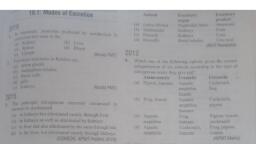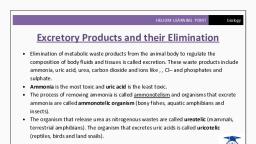Page 1 :
19.1 Human, , Excretory, System, , 19.2 Urine Formation, , 19.3 Function of te, Tubules, , 19.4 Mechanism of, Concentrationof, the Piltrate, , 19.5 Regulation of, Kidney Function, , 19.6 Micturition, , 19.7 Role of other, Organs tn, Excretion, , 19.8 Disorders of the, Excretony, System, , Excretory Propucts anp, THEIR _EviminatTion, , Animals accumulate ammonia, urea, uri¢ acid, carbon dioxide, water, and ions like Na*, K*, CL, phosphate, sulphate, etc., either by metabolic, activities or by other means like excess ingestion. These substances have, to be removed totally or partially. In this chapter, you will learn the, mechanisms of elimination of these substances with special emphasis on, common nitrogenous wastes. Ammonia, urea and uric acid are the major, forms of nitrogenous wastes excreted by the animals. Ammonia ts the, most toxic form and requires large amount of water for its climination,, whereas uric acid, being the least toxic, can be removed with a minimum, loss of water., , ‘The process of excreting ammonia is Ammonotelism. Many bony fishes,, aquatic amphibians and aquatic insects are ammonotelic in nature., Ammonia, as itis readily soluble, is generally excreted by diffusion across, body surfaces or through gill surfaces [in fish) as ammonium ions. Kidneys, do not play any significant role in its removal. Terrestrial adaptation, necessitated the production of lesser toxic nitrogenous wastes like urea, and uric acid for conservation of water. Mammals, many terrestrial, amphibians and marine fishes mainly exerete urea and are called ureotelic, animals, Ammonia produced by metabolism is converted into urea in the, liver of these animals and released into the blood which ts filtered and, excreted out by the kidneys, Some amount of urea may be retained in the, kidney matrix of some of these animals to maintain a desired osmolarity., Reptiles, birds, land snails and insects excrete nitrogenous wastes as uric, acid tn the form of pellet or paste with a minimum loss of water and are, called uricotelic animals., , , , 2021-22
Page 2 :
Asurvey of animal kingdom presents a variety of excretory structures., In most of the invertebrates, these structures are simple tubular forms, whereas vertebrates have complex tubular organs called kidneys. Some, of these structures are mentioned here. Protonephridia or flame cells are, , the excretory structures in Platyhelmintffts two: ees.. Planaria),, r “rs, some anneli alochordate — Amphioxus,, Protonep! primarily concerned ionic and fluid volume, , regulation, i.c., osmoregulation. Nephridia are the tubular excretory, , structures of earthworms and ot!, nitrogenou:, , elids. Nephridia help to remove, , tain a fluid and ionic balance. Mevishian, tebedessrrt the excretory structures of most of the insect#fncluding, , cockroaches. Malpighian tubules help in the removal of nitrogenous, , wastes and osmoregulation. p> soe aa glands perform, the excretory function in crustaceans like prawns:, , 19.1 Human Excretory System, , In humans, the excretory system consists, of a pair of kidneys, one pair of ureters. a, urinary bladder and a urethra (Figure, 19.1). Kidneys are reddish brown, bean, , shaped structures situated between the, levels of last thoracic and third lumbar, vextebra close TO TNE TISrSal inner wall of, i abominl eaty—e Ey minal cavity: of an, adult hum easures 10-12 cm in, length, 5-7 em in width, 2-3 cm in, thickness with an average weight of 120170 g. Towards the centre of the inner, concave surface of the kidney is a notch, called hilum through which ureter, blood, vessels and nerves enter. Inner to the hilum, is a broad funnel shaped space called the, renal pelvis with projections called calyces., The outer layer of kidney ts a tough, capsule. Inside the kidney, there are two, zones, an outer cortex and an inner, medulla. The medulla 1s divided into a few, conical masses (medullary pyramids), projecting into the calyces (sing.: calyx)., The cortex extends in between the, , Adrenal gland, , , , , , Inferior, , vena Cava a artery, , Pelvis - Renal vein, , Medulla, , Cortex™, — Dorsal aorta, , Ureter, , — Urinary, bladder, , —— Urethra, , Figure 19.1 Human Urinary system
Page 3 :
BioLocy, , Medullary medullary pyramids as renal columns called, pyramid Columns of Bertini (Figure 19.2)., , Each kidney has nearly one million, complex tubular structures called nephrons, (Figure 19.3), which are the functional units., Each nephron has two parts ~ the, glomerulus and the renal tubule., Glomerulus is a tuft of capillaries formed by, Cortex: q Renal vein the afferent arteriole - a fine branch of renal, Renal pelvis artery. Blood from the glomerulus is carried, Ureter away by an efferent arteriole., , The renal tubule begins with a double, walled cup-like structure called Bowman's, capsule, which encloses the glomerulus., Glomerulus alongwith Bowman’s capsule, is, , Figure 19.2 Longitudinal section (Diagrammatic) called the malpighian body or renal, of Kidney ecorpuscle (Figure 19.4), The tubule, , continues further to form a highly coiled, , network — proximal convoluted tubule, , Renal, column, , Calyx, , Renal artery, , capsule, , S, , Afferent a Efferent arteriole, arteriole a, , , , , , , , , , Glomerulus _, Bowman's, eepoule ~—— Proximal, convoluted, tubule, Distal, convoluted, | Descending limb tubule, of loop of Henle, Tlenle's loop, | Ascending limb ——, __ of loop of Henle, Vasa recta Collecting duct, , Figure 19.3 A diagrammatic representation of a nephron showing blood vessels,, duct and tubule
Page 4 :
(PCT). A hairpin shaped Henle’s loop is the Afferent arteriole, next part of the tubule which has a, descending and an ascending limb. The, ascending limb continues as another highly, coiled tubular region called distal, convoluted tubule (DCT). The DCTs of many, nephrons open into a straight tube called, collecting duct, many of which converge and, open into the renal pelvis through medullary, pyramids in the calyces,, , The Malpighian corpuscle, PCT and DCT, of the nephron are situated in the cortical, region of the kidney whereas the loop of Henle, dips into the medulla. In majority of, nephrons, the loop of Henle is too short and, extends only very little into the medulla. Such, nephrons are called cortical nephrons, In, some of the nephrons, the loop of Henle is, very long and runs deep into the medulla., These nephrons are called juxta medullary, nephrons., , The efferent arteriole emerging from the glomerulus forms a fine, capillary network around the renal tubule called the peritubular, capillaries. A minute wasgel of this network rans parallel to the Henle’s, loop forming a ‘U" shaped recta is absent or highly, reduced in cortical nephrons., , Efferent, arteriole, , , , , __ Bowman's, capsule, , — Proximal, convoluted tubule, , Figure 19.4 Malpighian body (renal corpuscle), , 19.2 Urine Formation, , Urine formation involves three main processes namely, glomerular, filtration, reabsorption and secretion, that takes place in different parts of, the nephron,, , The first step in urine formation is the filtration of blood, which is carried, out by the glomerulus and is called glomerular filtration. On an average,, 1100-1200 ml of blood is filtered by the kidneys per minute which constitute, roughly 1/5“ of the blood pumped out by each ventricle of the heart ina, minute. The glomerular capillary blood pressure causes filtration of blood, through 3 layers, t.e., the endothelium of glomerular blood vessels, the, epithelium of Bowman's capsule and a basement membrane between these, two layers. The epithelial cells of Bowman's capsule called podocytes are, arranged in an intricate manner so as to leave some minute spaces called, filtration slits or slit pores. Blood is filtered so finely through these, membranes, that almost all the constituents of the plasma except the, proteins pass onto the lumen of the Bowman's capsule. Therefore, it is, considered as a process of ultra filtration.
Page 5 :
294, , , , ‘The amount of the filtrate formed by the kidneys per minute is called, glomerular filtration rate (GFR). GFR in a healthy individual ts, approximately 125 ml/minute, t.e., 180 litres per day!, , The kidneys have built-in mechanisms for the regulation of glomerular, filtration rate. One such efficient mechanism ts carried out by juxta, glomerular apparatus (JGA). JGA is a special sensitive region formed by, cellular modifications in the distal convoluted tubule and the afferent, arteriole at the location of thetr contact. A fall in GFR can activate the JG, cells to release renin which can stimulate the glomerular blood flow and., thereby the GFR back to normal., , Acomparison of the volume of the filtrate formed per day (180 litres, per day) with that of the urine released (1.5 litres), suggest that nearly 99, per cent of the filtrate has to be reabsorbed by the renal tubules, This, process is called reabsorption, The tubular epithelial cells in different, segments of nephron perform this either by active or passive mechanisms., For example, substances like glucose, amino acids, Na’, ete.. in the filtrate, are reabsorbed actively whereas the nitrogenous wastes are absorbed by, passive transport. Reabsorption of water also occurs passively tn the initial, segments of the nephron (Figure 19.5)., , During urine formation, the tubular cells secrete substances like H*,, K* and ammonia into the filtrate. Tubular secretion is also an important, step in urine formation as it helps in the maintenance of tonite and acid, base balance of body fluids,, , 19.3 Function or tHE Tupuies, , Proximal Convoluted Tubule (PCT): PCT is lined by simple cuboidal, brush border epithelium which increases the surface area for reabsorption,, Nearly all of the essential nutrients, and 70-80 per cent of electrolytes, and water are reabsorbed by this segment. PCT also helps to maintain, the pH and ionie balance of the body fluids by sclective secretion of, hydrogen ions, ammonia and potassium ions into the filtrate and by, absorption of HCO, from it,, , Henle’s Loop: Reabsorption is minimum in its ascending limb., However, this region plays a significant role in the maintenance of high, osmolarity of medullary interstitial uid, The descending limb of loop of, Henle is permeable to water but almost tmpermeable to electrolytes. This, concentrates the filtrate as it moves down. The ascending limb is, impermeable to water but allows transport of electrolytes actively or, passively. Therefore, as the concentrated filtrate pass upward, it gets, diluted duc to the passage of electrolytes to the medullary fluid., , Distal Convoluted Tubule (DCT): Conditional reabsorption of Na’, and water takes place in this segment. DCT is also capable of reabsorption, of HCO, and selective secretion of hydrogen and potassium ions and, NH, to maintain the pH and sodium-potassium balance in blood.




















